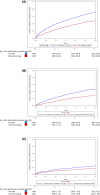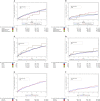Device Therapies Among Patients Receiving Primary Prevention Implantable Cardioverter-Defibrillators in the Cardiovascular Research Network
- PMID: 29581222
- PMCID: PMC5907599
- DOI: 10.1161/JAHA.117.008292
Device Therapies Among Patients Receiving Primary Prevention Implantable Cardioverter-Defibrillators in the Cardiovascular Research Network
Abstract
Background: Primary prevention implantable cardioverter-defibrillators (ICDs) reduce mortality in selected patients with left ventricular systolic dysfunction by delivering therapies (antitachycardia pacing or shocks) to terminate potentially lethal arrhythmias; inappropriate therapies also occur. We assessed device therapies among adults receiving primary prevention ICDs in 7 healthcare systems.
Methods and results: We linked medical record data, adjudicated device therapies, and the National Cardiovascular Data Registry ICD Registry. Survival analysis evaluated therapy probability and predictors after ICD implant from 2006 to 2009, with attention to Centers for Medicare and Medicaid Services Coverage With Evidence Development subgroups: left ventricular ejection fraction, 31% to 35%; nonischemic cardiomyopathy <9 months' duration; and New York Heart Association class IV heart failure with cardiac resynchronization therapy defibrillator. Among 2540 patients, 35% were <65 years old, 26% were women, and 59% were white. During 27 (median) months, 738 (29%) received ≥1 therapy. Three-year therapy risk was 36% (appropriate, 24%; inappropriate, 12%). Appropriate therapy was more common in men (adjusted hazard ratio [HR], 1.84; 95% confidence interval [CI], 1.43-2.35). Inappropriate therapy was more common in patients with atrial fibrillation (adjusted HR, 2.20; 95% CI, 1.68-2.87), but less common among patients ≥65 years old versus younger (adjusted HR, 0.72; 95% CI, 0.54-0.95) and in recent implants (eg, in 2009 versus 2006; adjusted HR, 0.66; 95% CI, 0.46-0.95). In Centers for Medicare and Medicaid Services Coverage With Evidence Development analysis, inappropriate therapy was less common with cardiac resynchronization therapy defibrillator versus single chamber (adjusted HR, 0.55; 95% CI, 0.36-0.84); therapy risk did not otherwise differ for Centers for Medicare and Medicaid Services Coverage With Evidence Development subgroups.
Conclusions: In this community cohort of primary prevention patients receiving ICD, therapy delivery varied across demographic and clinical characteristics, but did not differ meaningfully for Centers for Medicare and Medicaid Services Coverage With Evidence Development subgroups.
Keywords: arrhythmia; implantable cardioverter‐defibrillator; inappropriate shock; outcomes research; sudden cardiac death.
© 2018 The Authors. Published on behalf of the American Heart Association, Inc., by Wiley.
Figures



References
-
- Moss AJ, Hall WJ, Cannom DS, Daubert JP, Higgins SL, Klein H, Levine JH, Saksena S, Waldo AL, Wilber D, Brown MW, Heo M; for the Multicenter Automatic Defibrillator Implantation Trial Investigators . Improved survival with an implanted defibrillator in patients with coronary disease at high risk for ventricular arrhythmia. N Engl J Med. 1996;335:1933–1940. - PubMed
-
- Moss AJ, Zareba W, Hall WJ, Klein H, Wilber DJ, Cannom DS, Daubert JP, Higgins SL, Brown MW, Andrews ML; for the Multicenter Automatic Defibrillator Implantation Trial II Investigators . Prophylactic implantation of a defibrillator in patients with myocardial infarction and reduced ejection fraction. N Engl J Med. 2002;346:877–883. - PubMed
-
- Bardy GH, Lee KL, Mark DB, Poole JE, Packer DL, Boineau R, Domanski M, Troutman C, Anderson J, Johnson G, McNulty SE, Clapp‐Channing N, Davidson‐Ray LD, Fraulo ES, Fishbein DP, Luceri RM, Ip JH; for the Sudden Cardiac Death in Heart Failure Trial (SCD‐HeFT) Investigators . Amiodarone or an implantable cardioverter‐defibrillator for congestive heart failure. N Engl J Med. 2005;352:225–237. - PubMed
-
- Bhavnani SP, Giedrimeiene D, Coleman CI, Guertin D, Azeem M, Kluger J. The healthcare utilization and cost of treating patients experiencing inappropriate implantable cardioverter defibrillator shocks: a propensity score study. Pacing Clin Electrophysiol. 2014;37:1315–1323. - PubMed
-
- Poole JE, Johnson GW, Hellkamp AS, Anderson J, Callans DJ, Raitt MH, Reddy RK, Marchlinski FE, Yee R, Guarnieri T, Talajic M, Wilber DJ, Fishbein DP, Packer DL, Mark DB, Lee KL, Bardy GH. Prognostic importance of defibrillator shocks in patients with heart failure. N Engl J Med. 2008;359:1009–1017. - PMC - PubMed
Publication types
MeSH terms
Grants and funding
LinkOut - more resources
Full Text Sources
Other Literature Sources
Medical

